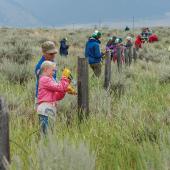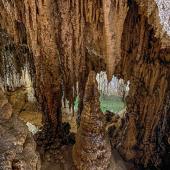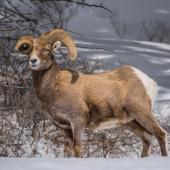Dust, Blood & Love
I walk on concrete wherever I go. The windows around me reflect pictures of the sky. I travel on trains through the tunnels, no wind in my hair. Then feel the pulse of swift life with fast steps. The people are oddly quiet as paper flies by on the breeze. Their hands are pressed to their heads in the cellular way. Nobody screams because the cars make the noise here. Roads, streets, and freeways are the colors of the urban palette; West Coast or East, it makes no difference. The cars are fast-moving, intrusive, running on six lanes or eight. If you’re walking you will soon find you are late.
Feeling the concrete, and witnessing the sprawl, I slip into daydreams of hot days with chilling rivers. I imagine a night sky filled with more than just the moon. I remember the possibility of running through the mountains, or the thrill of stalking elk on a sharp autumn morning. These are just a few of the images that come to me while I’m moving through the flow of the city. The humanity here is something to be celebrated while the treasures of the earth are not forgotten. Living in Bozeman, surrounded by the immense, seemingly endless abundance of nature, it is easy to look past the need for conservation. Fighting for congressional protection against irresponsible mining and gas drilling means sacrificing some of our own mechanized activity in these unique places. There is only one Montana. A vulnerable place in need of protection from the special interests that would exploit and forever unearth the beautiful places we call home. Measures must be taken, as they were by so few of our forefathers, to ensure that the wild places will forever remain wild.
At the present time there is more than hope on our side. A handful of people paved the way for Lyndon B. Johnson to sign the Wilderness Act of 1964. This Act is one of the most powerful weapons we have to protect Montana from special interest groups concerned with nothing but their own profit margin. In 1956, Howard Zahniser, executive director of the Wilderness Society, drafted a bill to permanently protect some of the nation’s remaining wilderness. After being introduced by Representatives Hubert Humphrey (D-MN) and John Saylor (R-PA), the bill underwent 66 rewrites over an eight-year period before finally being signed into action on Sept. 3, 1964.
Under the protection of this Act, a Wilderness Area is intended to be kept as a place “where the earth and its community of life are untrammeled by man, where man
himself is a visitor who does not remain.” Wilderness is further defined as “an area of undeveloped Federal Land retaining its primeval character and influence, without permanent improvements or human habitation, which is protected and managed so as to preserve its natural conditions.” By definition, then, we have been given a place free from cars and roads, a place with no permanent human occupation where wildlife and its habitat will be left in a natural condition.
While this Act created the framework of the National Wilderness Preservation system, it did not inherently save all of the “wild” places that existed at that time. This Act was created as a tool that needs to be continually used and maintained to sustain its effectiveness and purpose. To that end, the late Senator Metcalf (D-MT) set his aim on using this Act to preserve wild lands that had not yet been designated as wilderness by congress. In 1977 he shepherded the Montana Wilderness Study Act through congress. While not gaining Wilderness designations for these areas at that time, this Act did provide that these nine areas be preserved in their 1977 state until they were designated as Wilderness by congress at some later time. One of the nine original areas, the Lee Metcalf area, was given congressional wilderness status in 1983.
There are many more lands in our National Park system that need this congressional protection. There are wild lands in our National Forests and BLM land that desperately need help to gain congressional protection as well. We have the legal foundation to protect our wild places. The next step is to give a voice to the land through direct action in conservation. Bozeman is host to a multitude of organized citizens already hot on the trail of the current events shaping our natural landscape. These people are your neighbors, and the land I speak of is your home. No one else can do it for you.








